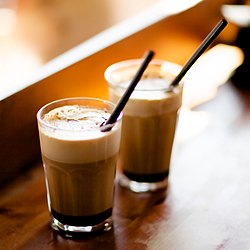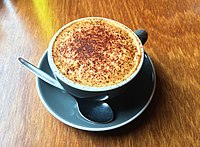Caffè mocha
 Caffè mocha with a layer of espresso | |
| Alternative names | Mocaccino, mochaccino, mochachino |
|---|---|
| Type | Beverage (hot and iced), milk coffee |
| Place of origin | Yemen |
| Region or state | Mokha, Taiz |
| Main ingredients | Chocolate, espresso, and hot milk |
| Variations | White caffè mocha |
A caffè mocha (/ˈmɒkə/ MOK-ə or /ˈmoʊkə/ MOH-kə), also called mocaccino (Italian: [mokatˈtʃiːno]), is a chocolate-flavoured warm beverage that is a variant of a caffè latte,[1] commonly served in a glass rather than a mug. Other commonly used spellings are mochaccino[2] and also mochachino. The name is derived from the city of Mokha, Taiz Governorate, Yemen, which was one of the centres of early coffee trade.[3] The name is sometimes shortened to just mocha.
Origin
The name "mocha" is derived from the Yemeni port of Mokha, which was a port well-known for its coffee trade from the 15th to 17th century,[4] and where small quantities of fine coffee grown in the hills nearby was exported.[5] When coffee drinking culture spread to Europe, Europeans referred to coffee imports from Arabia as Mochas, even though coffee from Yemen itself was uncommon and frequently mixed with beans from Abyssinia, and later coffee from Malabar or the West Indies were also marketed as Mocha coffee.[5][6]
The coffee drink today called "mocha," however, is made by adding chocolate, and some believe that this is the result of confusion caused by the chocolate flavor that may sometimes be found in Yemeni coffee.[7] Chocolate has been combined with coffee after chocolate drink was introduced to Italy in the 17th century; in Turin, chocolate was mixed with coffee and cream to produce bavareisa, which evolved in the 18th century into bicerin served in small clear glass where its components may be observed as three separate layers.[8] However, prior to 1900s, Mocha referred to Yemeni coffee, and its meaning began to change around the turn of the 20th century, and recipes for food such as cakes that combined chocolate and coffee that referenced mocha began to appear. In 1920, a recipe for a "Chilled Mocha" was published with milk, coffee and cocoa as ingredients.[7]
Characteristics

Like caffè latte, caffè mocha is based on espresso and hot milk but with added chocolate flavouring and sweetener, typically in the form of cocoa powder and sugar. Many varieties use chocolate syrup instead, and some may contain dark or milk chocolate.
Caffè mocha, in its most basic formulation, can also be referred to as hot chocolate with (e.g., a shot of) espresso added. Like cappuccino, caffè mochas typically contain the distinctive milk froth on top; as is common with hot chocolate, they are sometimes served with whipped cream instead. They are usually topped with a dusting of either cinnamon, sugar or cocoa powder, and marshmallows may also be added on top for flavour and decoration.[9]

A variant is white caffè mocha, made with white chocolate instead of milk or dark.[10] There are also variants of the drink that mix the two syrups; this mixture is referred to by several names, including black-and-white mocha, marble mocha, tan mocha, tuxedo mocha, and zebra mocha.
Another variant is a mochaccino which is an espresso shot (double) with either a combination of steamed milk and cocoa powder or chocolate milk. Both mochaccinos and caffè mocha can have chocolate syrup, whipped cream and added toppings such as cinnamon, nutmeg or chocolate sprinkles.[11] French White Mocha is another name for Mochaccino, without cinnamon powder.
A third variant on the caffè mocha is to use a coffee base instead of espresso. The combination would then be coffee, steamed milk, and the added chocolate. This is the same as a cup of coffee mixed with hot chocolate. The caffeine content of this variation would then be equivalent to the coffee choice included.
The caffeine content is approximately 430 mg/L (12.7 mg/US fl oz), which is 152 mg for a 350 mL (12 US fl oz) glass.[12]
See also
References
- ^ Campbell, Dawn; Smith, Janet L. (1993). The Coffee Book. Pelican. p. 98. ISBN 0882899503.
- ^ "mochaccino". Oxford Dictionaries. Oxford University Press. Archived from the original on 31 March 2017. Retrieved 30 March 2017.
- ^ *"Mocha | Definition of Mocha by Oxford Dictionary on Lexico.com also meaning of Mocha". Lexico Dictionaries | English. Archived from the original on 3 July 2020. Retrieved 2 July 2020.
- Eschner, Kat. "Your Mocha is Named After the Birthplace of the Coffee Trade". Smithsonian Magazine. Archived from the original on 11 September 2020. Retrieved 3 July 2020.
- ^ Hestler, Anna; Spilling, Jo-Ann (2010). Yemen. Marshall Cavendish Benchmark. p. 136. ISBN 9780761448501. Archived from the original on 2 May 2023. Retrieved 2 May 2023.
- ^ a b Yemen Ecology, Nature Protection Laws and Regulations Handbook Volume 1 Strategic Information and Basic Laws. International Business Publications. 2013. p. 228. ISBN 9781433075322.
- ^ Hewett, Charles (1864). Chocolate and Cocoa. E. & F.N. Spon. p. 42. Archived from the original on 1 May 2023. Retrieved 1 May 2023.
- ^ a b Alameri, Rua’a. "How Yemen once introduced the world to mocha coffee". Alarabiya News. Archived from the original on 2 October 2022. Retrieved 1 May 2023.
- ^ Turback, Michael (2013). Mocha. Clarkson Potter/Ten Speed. ISBN 9780307762269. Archived from the original on 13 May 2023. Retrieved 1 May 2023.
- ^ Mendez, Dayvin. "This History of: Mocha Coffee". scribe.usc.edu. Archived from the original on 20 May 2023. Retrieved 20 May 2023.
- ^ Vincenzo, Luca (April 2012). How to Make Coffee So Good You'll Never Waste Money on Starbucks Again. Waterbury Publishers. ISBN 978-1-938895-01-2. Archived from the original on 14 January 2024. Retrieved 27 May 2023.
- ^ Thurston, Robert W.; Morris, Jonathan; Steiman, Shawn (10 October 2013). Coffee: A Comprehensive Guide to the Bean, the Beverage, and the Industry. Rowman & Littlefield Publishers. p. 277. ISBN 978-1-4422-1442-2. Archived from the original on 14 January 2024. Retrieved 27 May 2023.
- ^ "Caffeine Content of Drinks". Caffeine Informer. Archived from the original on 2 August 2021. Retrieved 4 June 2010.

